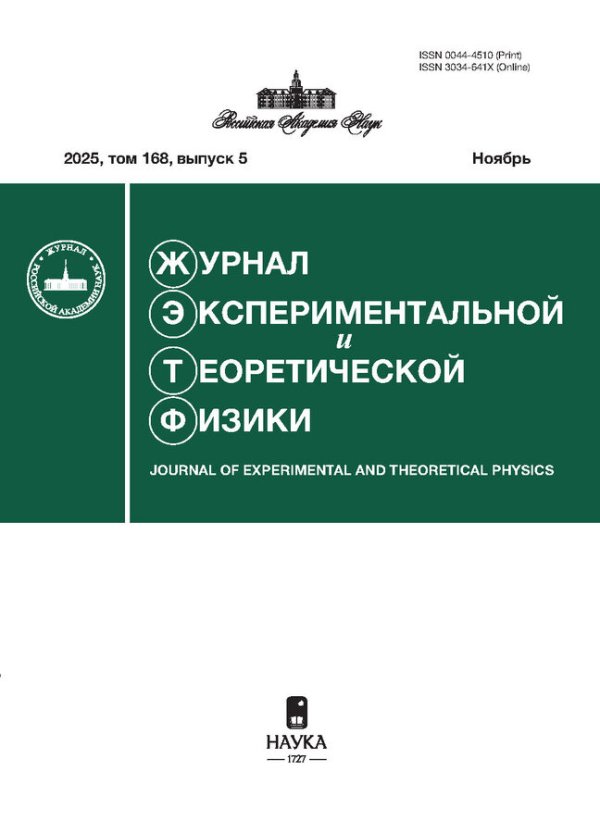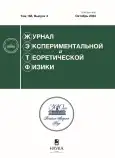Том 166, № 4 (2024)
МЕТОД ОЦЕНКИ КОЛИЧЕСТВА АТОМОВ В МАГНИТООПТИЧЕСКИХ ЛОВУШКАХ
Аннотация
Представлен и подробно рассмотрен метод оценки количества атомов в магнитооптической ловушке и в потоке из источника горячих атомов. Проанализирована применимость метода на различных этапах охлаждения. Рассчитана относительная неопределенность рассматриваемого метода. Представлены результаты применения описанного метода на оптических стандартах частоты на холодных атомах стронция и иттербия.
 447-452
447-452


ИСТОЧНИКУЛЬТРАХОЛОДНЫХ АТОМОВ 87Rb ДЛЯ АТОМНОГО ИНТЕРФЕРОМЕТРА-ГРАВИМЕТРА
Аннотация
Представлены результаты экспериментальных исследований по созданию источника ультрахолодных атомов 87Rb для абсолютного квантового гравиметра на основе атомной интерференции. В результате исследований реализовано субдоплеровское охлаждение атомов 87Rb в магнитооптической ловушке и получено облако ∼ 107 − 108 атомов с температурой 6 мкК. С помощью микроволнового излучения и оптической накачки осуществлена подготовка ультрахолодных атомов в начальном состоянии |F = 1, mF = 0〉 и проведены эксперименты по наблюдению резонансов Рамси на переходе |F = 1, mF = 0〉 → |F = 2, mF = 0〉 при взаимодействии облака атомов с однонаправленными рамановскими импульсами излучения.
 453-459
453-459


ЭФФЕКТЫ КОГЕРЕНТНОСТИ МАГНИТНЫХ ПОДУРОВНЕЙ, ИНДУЦИРОВАННЫЕ ПОЛЕМ ВОЛНЫ ЛИНЕЙНОЙ ПОЛЯРИЗАЦИИ, В СПЕКТРАХ НАСЫЩЕННОГО ПОГЛОЩЕНИЯ И МАГНИТНОГО СКАНИРОВАНИЯ В АТОМАХ С Λ- И V-ТИПАМИ ПЕРЕХОДОВ
Аннотация
Аналитически и численно показано, что эффект магнитной когерентности (интерференции) уровней в Λ- и V-типах переходов, индуцируемый полем бегущей линейно поляризованной электромагнитной (ЭМ) волны произвольной интенсивности, может вносить значительный вклад как в населенности уровней переходов (более ∼ 50% от полевого вклада), так и в спектры резонансов поглощения при частотном и магнитном сканировании. Выявлены различия в проявлении эффекта магнитной когерентности в населенностях уровней на открытых и закрытых типах переходов. Установлено, что в спектрах резонансов поглощения при магнитном сканировании вблизи нуля магнитного поля формируются узкие когерентные резонансы электромагнитно-индуцированной прозрачности (ЭИП). Исследованы зависимости параметров резонансов ЭИП от характеристик атомных переходов и интенсивности ЭМ-волны. Выявлен вклад эффекта магнитной когерентности уровней переходов в форму этих резонансов.
 460-474
460-474


МЕТОДЫ И СИСТЕМЫ СРАВНЕНИЯ ЧАСТОТ ТЕРРИТОРИАЛЬНО УДАЛЕННЫХ ОПТИЧЕСКИХ СТАНДАРТОВ
Аннотация
Рассматриваются работы для будущего переопределения секунды на основе квантового перехода в оптическом диапазоне. Уточнен бюджет неопределенности оптического стандарта частоты Sr-1 на основе ультрахолодных атомов стронция, включенного в состав Государственного первичного эталона времени и частоты. Излагается описание различных способов сравнения частот удаленных оптических стандартов частоты для реализации «дорожной карты», принятой на XXVII Генеральной конференции мер и весов. Перечислены точностные характеристики, предельно достижимые при использовании описанных способов, проводится их сравнение.
 475-489
475-489


СВЧ РАДИАЦИОННЫЕ ПЕРЕХОДЫ МЕЖДУ ТРИПЛЕТНЫМИ РИДБЕРГОВСКИМИ СОСТОЯНИЯМИ АТОМОВ ЩЕЛОЧНОЗЕМЕЛЬНО-ПОДОБНЫХ ЭЛЕМЕНТОВ ГРУППЫ IIb (Zn, Cd, Hg) И ИТТЕРБИЯ Yb
Аннотация
Определены численные значения квантовых дефектов, использованные для расчетов частот и матричных элементов дипольных радиационных переходов СВЧ-диапазона между триплетными ридберговскими состояниями n3S1, n3P1, n3D2 и n3F3 серий атомов группы IIb с большими значениями главных квантовых чисел n > 20. Результаты расчетов в рамках полуэмпирических методов теории квантового дефекта и модельного потенциала Фьюса аппроксимированы квадратичными полиномами. Коэффициенты полиномов табулированы вместе с численными значениями частот и матричных элементов и могут быть использованы для измерения напряженности полей по СВЧ-индуцированному расщеплению резонанса электромагнитно-индуцированной прозрачности, для разработки и планирования исследований характеристик СВЧ-излучения с использованием ридберговских атомов.
 490-499
490-499


 500-503
500-503


МАГНИТООПТИЧЕСКИЕ ЛОВУШКИ ДЛЯ КАЛИЯ-39 И КАЛИЯ-40
Аннотация
Созданы магнитооптические ловушки для 39K и 40K. Одна и та же установка настраивается на пленение либо одного изотопа, либо другого. Захвачено 7 · 109 атомов 39K и 1.5 · 108 атомов 40K. Среди ловушек, наполняемых из зеемановского замедлителя, эти значения являются наибольшими для каждого изотопа. Для 40K впервые исследовано влияние столкновений с атомами теплового пучка на время накопления. Термометрия, выполненная при меньшем числе атомов, для 39K показала 4.5 мК и значительно меньше для 40K, 130 мкК, что ниже предела Летохова–Миногина–Павлика.
 504-516
504-516


ДВУХТЕМПЕРАТУРНОЕ РАСПРЕДЕЛЕНИЕ АТОМОВ В УСЛОВИЯХ СУБДОПЛЕРОВСКОГО ОХЛАЖДЕНИЯ
Аннотация
Рассматривается задача субдоплеровоского лазерного охлаждения атомов в условиях «оптической патоки» в полях, образованных встречными волнами с различными поляризационными конфигурациями, с полным учетом квантовых эффектов отдачи. Показано, что распределение холодных атомов не является равновесным, но тем не менее может быть аппроксимировано двумя гауссовыми функциями и, соответственно, охарактеризовано температурами «холодной» и «горячей» фракций. Проведен детальный анализ долей атомов во фракциях и их температур в зависимости от параметров световых полей. На основе полученных результатов можно ввести понятие средневзвешенной температуры, которая находится в соответствии со средней кинетической энергией атомов.
 517-526
517-526


ОПТИЧЕСКАЯ СТАБИЛИЗАЦИЯ ЗАРЯЖЕННЫХ ДИЭЛЕКТРИЧЕСКИХ НАНОЧАСТИЦ В ГИБРИДНЫХ ЛОВУШКАХ
Аннотация
Представлены результаты теоретического исследования динамики заряженных диэлектрических наночастиц в гибридной ловушке. Предложена новая конфигурация гибридной ловушки, состоящей из поверхностной электродинамической ловушки с прозрачными электродами и оптической дипольной ловушки, формируемой лазерным гауссовым пучком. Моделирование динамики проводилось для наночастиц диоксида кремния, локализованных в гибридной ловушке в воздушной среде с учетом вязкого трения. Показано, что интенсивность лазерного излучения дипольной ловушки может использоваться в качестве бифуркационного параметра рассматриваемой динамической системы для изменения положения равновесия наночастиц. Предложенная конфигурация гибридной ловушки может стать новой платформой для реализации оптомеханической машины Изинга.
 527-534
527-534


ОСЦИЛЛЯЦИИ РАБИ ПРИ ТРЕХФОТОННОМ ЛАЗЕРНОМ ВОЗБУЖДЕНИИ ОДИНОЧНОГО РИДБЕРГОВСКОГО АТОМА РУБИДИЯ В ОПТИЧЕСКОЙ ДИПОЛЬНОЙ ЛОВУШКЕ
Аннотация
В эксперименте по трехфотонному лазерному возбуждению 5S1/2 → 5P3/2 → 6S1/2 → 37P3/2 одиночного ридберговского атома 87Rb, захваченного в оптическую дипольную ловушку, впервые наблюдались трехфотонные осцилляции населенностей Раби между основным и ридберговским состоянием. Одиночный атом регистрировался оптическим методом по сигналу резонансной флуоресценции на малошумящей sCMOS-видеокамере. Измерялась относительная вероятность атому остаться в ловушке после действия трех синхронизованных возбуждающих лазерных импульсов с длительностями, изменяемыми от 100 нс до 2 мкс. Особенностью эксперимента было использование интенсивного лазерного излучения с длиной волны 1367 нм на второй ступени возбуждения, обеспечивающего однофотонную частоту Раби до 2 ГГц для управления эффективными отстройками промежуточных уровней трехфотонного перехода за счет динамического эффекта Штарка. Зарегистрированы осцилляции Раби с частотой от 1 до 5 МГц в зависимости от интенсивности лазерных импульсов первой и второй ступеней возбуждения при времени когерентности 0.7−0.8 мкс. Обсуждаются пути увеличения времени когерентности и контраста трехфотонных осцилляций Раби для применений в квантовой информатике с ридберговскими атомами.
 535-547
535-547


КОМПЕНСАЦИЯ СВЕТОВОГО СДВИГА РЕЗОНАНСОВ КОГЕРЕНТНОГО ПЛЕНЕНИЯ НАСЕЛЕННОСТЕЙ В ПАРАХ ЦЕЗИЯ ПРИ ИСПОЛЬЗОВАНИИ ДВОЙНОЙ ЧАСТОТНОЙ И АМПЛИТУДНОЙ МОДУЛЯЦИИ ЛАЗЕРНОГО ИЗЛУЧЕНИЯ
Аннотация
Исследуется световой (динамический штарковский) сдвиг резонансов когерентного пленения населенностей (КПН) в парах атомов цезия при их возбуждении излучением диодного лазера с вертикальным резонатором, ток которого модулируется на сверхвысокой частоте (≈ 4.6 ГГц). Такой подход используется в некоторых современных квантовых стандартах частоты (КСЧ) микроволнового диапазона. Один из основных факторов, приводящих к ухудшению долговременной стабильности частоты КСЧ, связан со световым сдвигом резонанса КПН из-за вариаций оптической мощности P в газовой ячейке. В настоящей работе показано, что при использовании дополнительного электрооптического модулятора, собранного по типу интерферометра Маха – Цендера, появляется возможность эффективно управлять амплитудами боковых полос в спектре излучения. Это позволяет находить такое оптимальное значение оптической мощности, вблизи которой сдвиг резонанса нечувствителен к малым ее изменениям. Результаты работы представляют интерес для развития КСЧ на основе КПН.
 548-555
548-555


ЛАЗЕРНОЕ ОХЛАЖДЕНИЕ ИОНА ИТТЕРБИЯ-171 БЕЗ ИСПОЛЬЗОВАНИЯ МАГНИТНОГО ПОЛЯ
Аннотация
Экспериментально реализована схема лазерного охлаждения иона 171Yb+ в радиочастотной ловушке с использованием трехчастотного лазерного поля, компоненты которого резонансны оптическим переходам линии 2S1/2 → 2P1/2, не требующего наличия магнитного поля. Исключение магнитного поля в цикле лазерного охлаждения позволяет осуществлять прецизионный контроль слабого магнитного поля (∼ 10−2Гс), используемого для спектроскопии часовых переходов в оптическом стандарте частоты на одиночном ионе иттербия, что важно для подавления сдвигов частоты, связанных с квадратичным эффектом Зеемана.
 556-565
556-565


DETECTION OF METRONIDAZOLE AND FAMPRIDINE BY NMR AT ZERO AND ULTRALOW MAGNETIC FIELD
Аннотация
In this work the biocompatible molecules — metronidazole and fampridine — were successfully hyperpolarized using parahydrogen via the signal amplification by reversible exchange approach. The nuclear magnetic resonance (NMR) signals from both molecules were detected at zero- to ultralow magnetic field (ZULF) using commercially available rubidium vapor magnetometer from QuSpin.
 566-570
566-570












